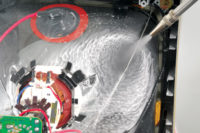3 Key Things to Know to Successfully Deploy Contents Inventory Software
Three key areas to consider when making an inventory system part of your restoration organization






The contents restoration workflow is like a car. When it runs properly, it’s hardly noticed. Only when a component breaks down and disrupts the owner’s daily routine does the car draw attention.
In much the same way, contents are a crucial part of the restoration cycle. Contents restoration professionals typically arrive first onsite and must pack out personal property before structural repair work can begin. Cleaning, reupholstering, storage, and other restoration work takes place at the warehouse away from the homeowner’s line of sight. And then, once the house has been restored, contents restorations professionals are the last ones in, returning prized belongings and a sense of normalcy to homeowners and their families.
To run like a well-oiled machine, a growing number of contents restoration organizations are turning to advances in contents inventory software. These systems offer attractive benefits, such as automating many inventorying and cataloguing steps, enhancing organization, eliminating redundant data entry, lowering labor costs, and increasing overall competitiveness.
Seamless deployment is vital to ensuring smooth restoration services so here are three areas to keep in mind when planning to make a contents inventory system part of the workflow.
Hardware and Infrastructure
Advanced contents estimating systems leverage mobile technology to increase efficiency both in the field and at the warehouse. Android and iOS-based apps offer restoration professionals tremendous flexibility in selecting the right devices for their company, or team members can even use the devices they already own.
Using these devices, pack-out crews can quickly catalogue individual contents items, capture photos to show pre-existing condition, and then mark it for cleaning, storage, or replacement, which provides robust documentation without sandbagging pack-outs. Apps for contents inventory systems are also designed to work equally well in connected and disconnected environments, allowing multiple team members to work on the same job simultaneously and merge their inventories at the completion of a pack-out.
At the warehouse, a solid Internet connection is necessary to improve coordination between various teams as well as to ensure everyone has the latest information about each item’s chain of custody. Inventories captured in the field automatically sync across the system and then can be imported directly into the restoration company’s estimating system, saving office staff time and eliminating repetitive data entry. When items are moved from a cleaning station to storage, their location and status can also be updated and immediately reflected throughout the system, ensuring each team member has a real-time view of the tens of thousands of items in the warehouse. Not only does this improve the chain of custody, it also bolsters customer service.
Suppose a homeowner needs to retrieve a set of antique china. With conventional tracking methods, the office staff would need to put him on hold, call the warehouse, and then wait while a team member rifles through pallets and boxes to find the item in question. With an inventory system that instantly updates across all devices, the office staff can look up the item’s exact location within moments and have it ready for pick up or delivery.
Training
Next, selecting the right method to train team members on the inventory system ensures an orderly restoration workflow. Typically, the new system can be introduced individually or as a team. Each approach has its pros and cons.
One-on-one training ensures the team member gets thoroughly acquainted with the new system, but can require more time and resources. On the other hand, group training is more efficient, but potentially less thorough. Ultimately, the decision depends on many factors, including company size and team members’ familiarity with mobile technology and inventory systems. An advanced contents inventory system with an intuitive interface that is easy to learn can ease the transition. Additionally, online training options and 24/7 support can also help team members quickly get up to speed.
Practice
Finally, practice is the best way to master a skill. Prior to deploying a contents inventory system on a live job, run a few drills. Walk through each step of the typical restoration workflow and keep a sharp eye out for any potential issues. This is the perfect opportunity to observe how well the crew knows the system. If multiple team members encounter the same issue, it might mean additional training is needed. After a few satisfactory dry runs, the team should be ready to go to work with the system in real-world scenarios.
An efficient, orderly workflow is the hallmark of successful contents restoration. By strategically implementing and deploying inventory software, contents restoration professionals will be able minimize cycle times, maximize coordination between team members, and run their organizations like a finely tuned engine.
Looking for a reprint of this article?
From high-res PDFs to custom plaques, order your copy today!








